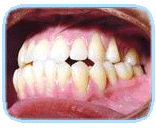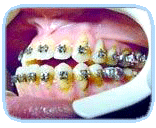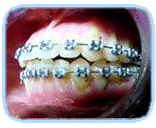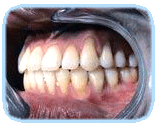Orthognathic Surgery
|
Jaw growth is a slow and gradual proce s s and i n some instances the upper and lower jaw or one side of the jaw to the other may grow at different rates. Ortho means straighten and gnathia means jaw and hence, orthognathic surgery means straightening of the jaw(s) by surgery. An Oral & Maxillofacial Surgeon or Plastic Surgeon practicesorthognathic surgery . Do not confuse orthognathic surgery with orthodontic therapy (braces). While Orthodontic treatment (braces) can correct many problems if only the teeth are involved Orthognathic Surgery maybe required if the jaws (bone) also need repositioning. When planning an orthognathic surgical case, the general dentist, orthodontist and oral surgeon will work closely with one another to set the stage for optimum post surgical results in regards to both function and esthetics. |
|
 |
 |
 |
 |
Before Orthognathic Surgery
After Orthognathic Surgery
Under what circumstances would you need orthognathic surgery ?
• Protruded lower jaw
• Retruded lower jaw
• Protruded upper jaw
• Retruded upper jaw
• Facial asymettry
• Gummy smile
At what age is the Orthognathic Surgery is most effective ?
The ideal age for Orthognathic surgery is after the growth periodhas been completed ( 18 years for girls and 20 years for boys )
What is involved in the treatment itself ?
These conditions may cause many functional and psychological problems. The good news is that they need not be permanent. Improvement, and often correction, can be attained with the proper procedure. It is a cosmetic surgery and the surgeon envisages changing the face of a person from distortion to proportion. The results of orthognathic surgery can have a dramatic and positive affect on many aspects of your life.
Evaluation : After the initial examination a thorough examination with facial measurements, photographs, x-rays, and dental impressions will be carried out. A complete medical examination will follow. This rules out any health problems that would interfere with the surgery or the administration of General Anesthesia.
Pre-surgical Orthodontia : The Oral & Maxillofacial Surgeon and the Orthodontist will work closely together during your treatment. Orthodontic treatment (braces) is started before surgery. The teeth are moved and repositioned into proper alignment before surgery if necessary.
Preparing for Surgery : The Orthognathic Surgery will take place in a hospital under general anesthesia. You will be admitted to the hospital one day prior to surgery and will be advised on dietary conditions for the days leading up to surgery. You will probably be required to stay in the hospital for a week or so until you have recovered from the surgery. You may need blood transfusion during the surgery. You will then undergo a full medical checkup. You should as always, maintain a good standard of oral hygiene before and after surgery.
Surgical Procedures : Orthognathic Surgery lasts anywhere from 1½ hours to several hours depending on the type of surgery needed. Incisions are made inside the mouth during surgery and there will be no visible external scars.
 TR
TR EN
EN RUS
RUS
